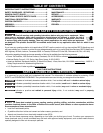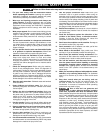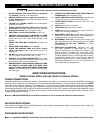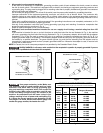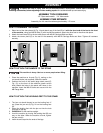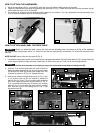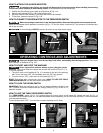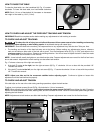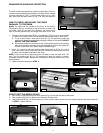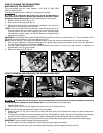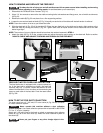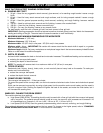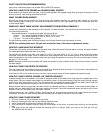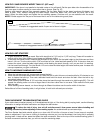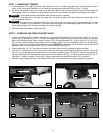
10
HOW TO CHECK AND ADJUST THE FEED BELT TRACKING AND TENSION
IMPORTANT: Read this complete section be fore making any adjustments to belt track ing or tension.
TO CHECK AND ADJUST TRACKING
To reduce the risk of injury, turn unit off and disconnect it from power source before installing and removing
accessories, before adjusting or when making repairs. An accidental start-up can cause injury.
IMPORTANT: Since the feed belt runs slowly, the response time to any adjustment may also be slow. Take your time.
1. The tracking and tension of the feed belt was set at the factory. Before making any adjustments, place a reference
mark on the table on either side of the belt with a pencil. Turn the feed/speed knob (E) Fig. 16 “ON” and adjust to the
maximum speed. Let the belt run. Observe the tracking direction. You will not need to adjust the belt If it does not make
any measurable side movement in five minutes.
NOTE: A new belt will usually be tighter on one side than the other. Frequent adjustments are normal for the first few hours
due to belt stretch. Adjustments to belt tracking can also affect belt tension.
Fig. 17 shows a close-up of the right set screw (B).
2. If the belt (F) tracks to the right, turn the right set screw (B) Fig. 17 clockwise 1/4 turn or less with the provided 1/8"
T-handle hex wrench.
3. If the belt (F) tracks to the left, turn the right set screw (B) Fig. 17 counter-clockwise 1/4 turn or less with the provided
1/8" T-handle hex wrench.
NOTE: Adjust one side and let the movement stabilize before adjusting again. Continue to tighten or loosen this
adjustment until the feed belt tracks properly.
TO CHECK AND ADJUST TENSION
If the belt slips on the rear drive roller during sanding operations, adjust the belt tension.
To adjust, turn both set screws (A) and (B) Fig. 16 clockwise in 1/4 turn increments.
NOTE: When adjusting the belt tension, turn both set screws the same amount. DO NOT over-tighten the belt. Excessive
tension will cause premature belt wear, bearing wear, and will overload the motor. Listen for motor load speed changes when
adjusting the belt tension.
NOTE: Adjustments to belt tension can affect belt tracking. Frequent adjustments are normal for the first few hours.
To raise the feed table, turn the handwheel (A) Fig. 15 counter-
clockwise. To lower the feed table, turn hand-wheel clockwise.
NOTE: Each 1/4 turn of handwheel (A) increases or decreases
the height of the table by 1/64" (.5 mm).
Fig. 16
Fig. 17
A
F
B
E B
HOW TO RAISE THE TABLE
Fig. 15
A



